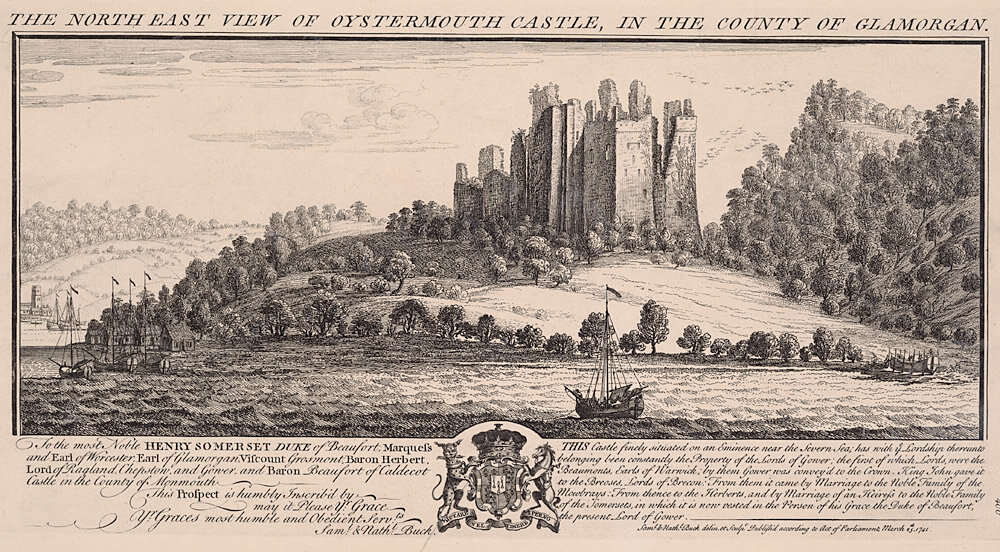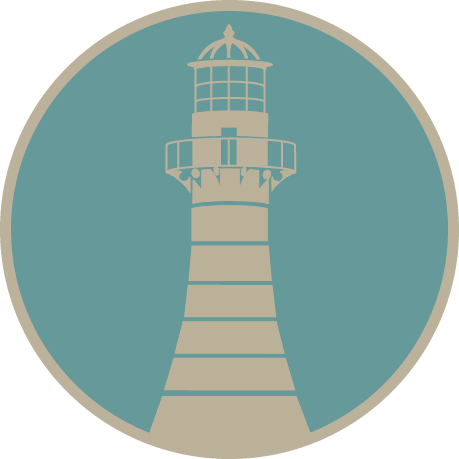History of Oystermouth Castle
Oystermouth Castle was built in Mumbles by a Norman Lord called William de Londres. Oystermouth Castle was a Norman castle that was part of a chain of castles that help provided rule over the Gower peninsula and its surrounding villages. In the year 1100, a Norman lord named Henry Beaumont took over Gower and is credited with the majority of the local castles. The de Londres family-owned Oystermouth Castle until about 1200, and then it was given back to the Lord of Gower. The Lord of Gower owned Oystermouth Castle from 1200 until about 1330 and the family was called the de Braose family. Alionara de Mowbray was the last of the de Broase family; she married into the de Mowbray family.
Castle locations were critical because they needed to be on high ground or on the edge of an impregnable cliff to provide a commanding view of the surrounding area. It was vital that each castle be half a day's march apart (roughly 3-6 miles) so that if there was an invasion, each castle could help defend the surrounding castles. William the Conqueror built castles to maintain control of land because he realised that the local population would not accept foreign rule without a fight. The Welsh were able to hold out for over a century. Castles were also built by William the Conqueror with a wider purpose, used as strong points, Norman soldiers were able to control a large number of Anglo Saxon peasants by using a castle as a base. William needed to keep control of his newly conquered kingdom, so he ordered castles to be built to protect and defend the land from constant rebellion. Gower was on the border of Norman control, and the Welsh controlled many parts of Wales, making it very uneasy with resentment.
The construction of Oystermouth took a long time. We know this because Oystermouth was only a wooden motte and bailey castle from the 11th to the 13th centuries. This, along with subsequent developments over a long period of time, resulted in the stone castle that exists today.
Early references can be found in "The Chronicles of the Princes," the earliest source from the C13th.
1093 “The French devastated Gower, Kidwelly and the Vale of Tawe; and the countries remained a desert.”
1116 “There was a castle in Gower which Gruffudd, son of Rhys, burned entirely.”
1215 “Lord Rhys, collecting a vast army, advanced on Gower.
He made for the castle of Oystermouth and he camped around it that night.
The following day he captured the castle, which with the town, he burned.”
This evidence suggests that the original castle remained a motte and bailey, as described in two accounts; it also states that the castle was "burned." Motte and bailey castles were mostly made of wood, which was a weakness because it was easily destroyed by fire. The Castle had also been attacked three times, twice burned, which explains why the castle's construction was so slow. There were several other reasons for the castle's construction as well. Early castles were not only great defence systems, but they also housed large communities.
Plan of Castle - Credit R Parmiter
The castle is constructed on high ground overlooking Swansea Bay. This allowed for defence against attackers coming both from inland and the sea. It is situated on the western of two ridges overlooking Swansea Bay's southern end and the town of Mumbles.
A view of the ruins of Oystermouth Castle with ships in the foreground. Buck, Samuel, 1696-1779 Buck, Nathaniel, artist. Buck, Samuel, 1696-1779, engraver.
The eastern ridge would have provided a better view of the sea but not a suitable water supply, If the castle was to withstand a siege, this would have been critical. The western ridge provided a more solid foundation for this massive stone structure. The second hill has stronger limestone foundations and is wider than the first, allowing for future growth. The hill in front, on the other hand, would have had an obvious blind spot, making it easier for attackers.
"Oystermouth (Swansea Bay)" engraved by W.Mossman after a picture by W.H.Bartlett, published in Finden's Ports and Harbours..., 1842
Oystermouth Castle, with its village and lighthouse, 1839
Oystermouth Castle was not the only castle built in Wales during this period. There are many other castles with as many similarities as there are differences. Just a few miles away is Penard Castle. Just like Oystermouth, It was built on high ground to defend the Gower coastline. However, this time it was built on a cliff, which gave it steeper slopes and made it more difficult to attack than Oystermouth. Swansea Castle was also built on a hill, but it was designed to protect the seaport.
The Normans needed to build many castles to protect themselves from Welsh rebellion and attacks that took place in 1136, 1189, and 1215. Gower has a ring of Castle and these include
Loughor Castle
Loughor Castle is a ruined, medieval fortification located in the town of Loughor, Wales. The castle was built around 1106 by the Anglo-Norman lord Henry de Beaumont, during the Norman invasion of Wales. The site overlooked the River Loughor and controlled a strategic road and ford running across the Gower Peninsula.
Swansea Castle
Swansea Castle is located in the city centre of Swansea, Wales, UK. It was founded by Henry de Beaumont in 1107 as the caput of the lordship of Gower. The castle is now ruined and only two blocks remain, though the site has been improved in the 2010s for use as a public space.
Oystermouth Castle
Oystermouth Castle is a Norman stone castle in Wales, overlooking Swansea Bay on the east side of the Gower Peninsula near the village of the Mumbles. The first castle was founded by William de Londres of Ogmore Castle soon after 1106 following the capture of Gower by the Normans. In 1116 the Welsh of Deheubarth retook the Gower Peninsula and forced William to flee his castle which was put to the torch. The castle was rebuilt soon afterwards, but was probably destroyed again in 1137 when Gower was once more retaken by the princes of Deheubarth.
Pennard Castle
Pennard Castle is a ruined castle, near the modern village of Pennard on the Gower Peninsula, in South Wales. The castle was built in the early 12th century as a timber ringwork following the Norman invasion of Wales
Penrice Castle
Penrice Castle is the 13th-century successor to a strong ringwork to the southeast, known as the Mounty Bank. It was built by the de Penrice family, who were given land there for their part in the Norman conquest of Gower.
Oxwich Castle
Oxwich Castle is a Grade I listed castle which occupies a position on a wooded headland overlooking Oxwich Bay on the Gower Peninsula, Wales. Although it may occupy the site of an earlier fortification, it is a castle in name only as it is a grand Tudor fortified manor house built in a courtyard style.
Weobley
Weobley Castle is a 14th-century fortified manor house on the Gower Peninsula, Wales, in the care of Cadw. The castle overlooks Llanrhidian saltmarshes and the Loughor estuary.
The development of Oystermouth Castle
Oystermouth was a motte and bailey castle from the 11th to the 13th centuries and they were made of earth and wood. The motte was typically a high mound made of piled-up earth. The top was flattened and a wooden tower called a keep was built on it, surrounded by a circular wooden palisade. This construction method was quick and simple to construct. Wooden motte and bailey castles were temporarily used when conquering an area and then changed to stone when the area was conquered.
The chronicles of the princes, states
“1093; The French devastated Gower”
“1116; there was a castle in Gower which Gruffudd, son of Rhys, burned entirely.”
“1215; Lord Rhys collecting a vast army, advanced on Gower. He made for the Castle of Oystermouth and he camped around it that night. The following day he captured their castle which, with the town, he burned.
Because Oystermouth was constantly attacked, it was continually repaired instead of being developed. Oystermouth Castle was built of stone in the 13th century, a century later than other castles.
This was because Oystermouth and the Gower had become more settled and were no longer vulnerable to attacks; if attacked again, it would no longer have the weakness of simply being burned; it could now function as a more conventional castle. By the 14th Century, Oystermouth Castle's gateway was reinforced, and the curtain wall was rebuilt. It also had its own chapel constructed and these features improved military protection.
Oystermouth Castle did have many other military features. It had a bailey, which was the courtyard. It had curtain walls, which surrounded the battlements. There is evidence to suggest a drawbridge was present in the gateway, as there were two holes above the entrance. However, the holes are not worn, therefore they must have used a rope (not a chain) to pull the drawbridge, as this would’ve been cheaper. The drawbridge is one of the castles more unusual features. Oystermouth also had a rectangular keep, entrance steps but no watchtower. It has been suggested that instead there were drum towers for a gatehouse
Oystermouth later became abandoned in the 15th century and wasn’t rebuilt after an attack, it is understood that it wasn’t needed for domestic or military use.
There is no early written evidence about Oystermouth Castle because when it was attacked in 1400, locals conquered it and then destroyed all records. “The closest we get to an earlier description is from a survey of Gower made in 1650 when Oliver Cromwell was its Lord: It mentions:
“An old decayed castle called Oystermouth Castle being for the present of no use, but of a very pleasant situation and near unto the sea side.”
Watchtowers were added for military strength and for a better view. Stone keeps were first developed in the 13th century and then followed by Curtain walls. A curtain wall usually replaced the wooden palisades with stone and was given the name “curtain walls.” These walls strengthened the entrance and usually the gatehouse
A Short Summary of the Caslte History
1106 - Henry Beaumont, Earl of Warwick became the first Norman Lord of Gower, when he divided the area among his followers the manor of Oystermouth was given to the de Londres family.
1116 - Gruffydd ap Rhys ap Tewdr invaded Gower and burnt Oystermouth Castle.
1136 - Large Norman force defeated by Hwyel ap Maredudd on Garngoch common.
1189 - Lord Rhys of Deheubarth plundered Gower.
1192 - Lord Rhys besieged Swansea for ten weeks.
1203 - King John gave Gower to William de Breos.
1215 - Rhys Grug and Rhys Ieunanc, allies of Llywelyn ap Iorwerth, attacked Swansea and then captured Oystermouth.
1257 - Llywelyn ap Gruffydd plundered Gower.
1284 - Extensive repairs and extensions to the castle completed for the visit of Edward I on 10th and 11th of December.
1287 - Rhys ap Maredudd attacked and burnt Swansea and captured Oystermouth.
1302 - William de Langton tried to bring complaints against the King and was kidnapped by John Iweyn, steward of Oystermouth Castle and held prisoner until he withdrew his claims.
1302 + 1314 William de Breos signs a bond and two grants at Oystermouth.
1329 - Alina de Mowbray dated a conveyance at Oystermouth.
1334 + 1350 - Alina's son John was at Oystermouth and made grants to the abbeys of Neath and Margam.
1403 - 1405 - Gower controlled by Owain Glyndwr.
1451 - Sir Hugh Johnys was constable of Oystermouth Castle.
1461 - Gower passes to the Herberts.
1927 - The Duke of Beaufort transfers Oystermouth Castle to Swansea Corporation.
1989 - Friends of Oystermouth Castle founded.






